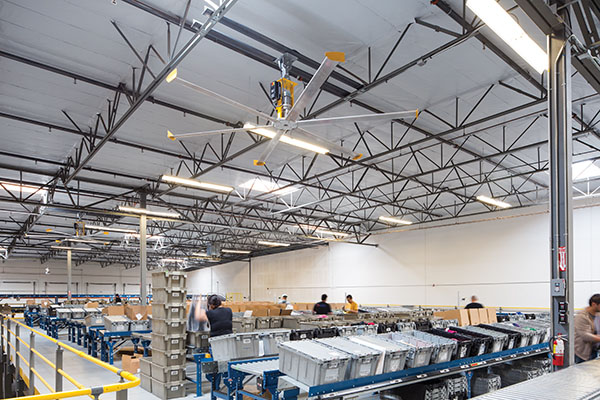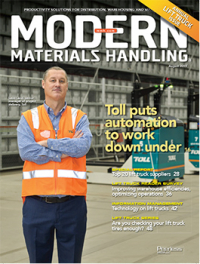Improved worker comfort increases DC productivity
Overhead fans facilitate airflow, increasing throughput and employee retention even on the hottest days.
Distribution center work is never easy, and it gets even tougher in summer heat. Put those DCs in Las Vegas, where the average July high temperature is 105°F, and the problem just got much worse.
That said, Esther Diedrich, director of distribution for Marshall Retail Group, knew she had to make some cooling accommodations in the company’s new Las Vegas DC. The facility supplies 160 specialty stores in casinos and airports across the country. Fortunately, she had some experience here.
At the company’s previous DC, it used numerous floor fans to circulate air blown from the company’s evaporative cooling systems. But there were drawbacks. Often, the fans themselves got in the way of operations. The cords on the DC floor were a safety hazard.
Furthermore, the fans were not energy efficient. Worker productivity and comfort were also on the line. Studies show that 77°F is an ideal temperature from a productivity perspective. At 90°F, productivity falls off almost 15%. By the time the temperature gets to 105°F, there is a 31% hit to productivity.
And if the temperature outside is 105°F, it was clearly going to be much higher in that new DC without some relief. Worker discomfort and dissatisfaction are just as important especially in an era of tight labor availability. What Diedrich needed was a DC that people wanted to work in and could meet high performance expectations.
Today, Marshall Retail uses three, 14-foot fans (Big Ass Fans) in its 64,000-square-foot DC. They complement the evaporative cooling system in the facility, circulating air throughout the facility including the racking where temperatures would otherwise be particularly oppressive. Employees working in picking aisles, pack lines and shipping docks all stay cool without more expensive air conditioning.
The airflow from the overhead and directional fans provides a cooling effect of up to 10 degrees. While the temperature in the space may be 90°F, the fans’ cooling effect makes people feel as if it’s only 80°F, erasing a productivity loss of more than 11%. The fans also dissipate excess body heat, which helps to protect workers from heat stress and fatigue.
“The fans have been working beautifully,” Diedrich said. “Even when temperatures rise to 110°F and higher, the fans really make a difference. The staff is more comfortable and more productive.”
When floor conditions are cooler during winter months, the fans gently recirculate heated air at the ceiling back down to where workers need it, helping them stay warm and focused. The average winter outdoor temperature in Las Vegas is 60°F. That may not be Boston winter temperatures, but it’s a far cry from summer heat.
Quite simply, more comfortable work conditions lead to greater job satisfaction and help reduce employee turnover year round, keeping skilled labor working and hiring costs down.

Article Topics
Ergonomics News & Resources
Advance Lifts marks 50th anniversary Shift Robotics demonstrates warehouse Moonwalkers HeroWear demonstrates a back-assist exosuit SIGI announces key leadership promotions Autoquip Corporation acquires German company J.A. Becker & Söhne Monorail Manufacturers Association celebrates 90 years of monorail best practices Caster Concepts expands manufacturing facility in Albion, Mich. More ErgonomicsLatest in Materials Handling
Geek+ and System Teknik deploy PopPick solution for pharmacy group Med24.dk Beckhoff USA opens new office in Austin, Texas Manhattan Associates selects TeamViewer as partner for warehouse vision picking ASME Foundation wins grant for technical workforce development The (Not So) Secret Weapons: How Key Cabinets and Asset Management Lockers Are Changing Supply Chain Operations MODEX C-Suite Interview with Harold Vanasse: The perfect blend of automation and sustainability Consultant and industry leader John M. Hill passes on at age 86 More Materials HandlingSubscribe to Materials Handling Magazine

Find out what the world's most innovative companies are doing to improve productivity in their plants and distribution centers.
Start your FREE subscription today.
April 2024 Modern Materials Handling

Latest Resources












